Social Workplace conference Paris 2017 took place last April 18th. Hereby the storify of the event:
Category: Non classé
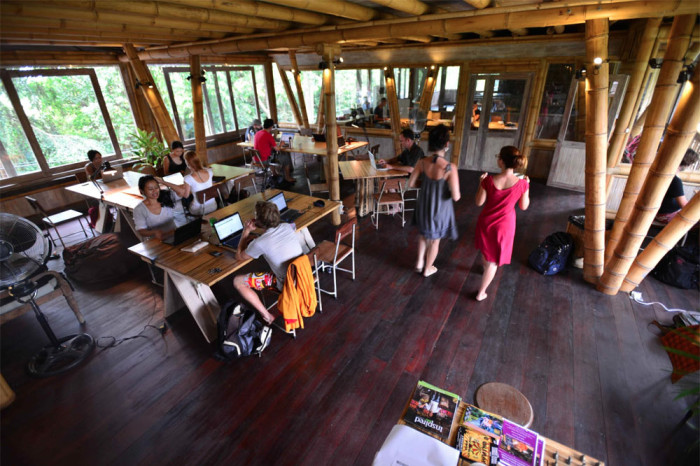
In January 2015, the Hubud team created and hosted Coworking Unconference Asia, which had around 120 attendees from around Asia. During the last session at the event, the team asked the audience whether or not they should form an Asian Coworking Alliance. The simple question led to an impassioned discussion about the potential alliance, concluding with 3 coworking spaces offered to take the discussion forward. As many coworkers and space managers know, it’s difficult to get there types of projects off the ground, especially because they are often born from passion, not revenue.
Fast forward to the 2nd Coworking Unconference Asia in 2016, and the CU Asia team decided to get things off the ground and launched the Coworking Alliance somewhat unilaterally. In its first year, CAAP has 30 paying member spaces and has offered 17 webinars for coworking space owners and staff. We caught up with the co-founder of Hubud, Steve Munroe, to discuss the coworking scene in Asia and how the formation of a coworking alliance can help global coworking communities grow.
Coworking has grown exponentially in some parts of Asia. Is the model considered to be a viable option for corporate players and local freelancers?
On that same note, what role do you see coworking playing in the context of redefining “traditional” work culture in the region?

Steve Munroe, co-founde Hubud, Bali
Are corporate entities in the region embracing coworking?
Who are the most likely members to join coworking spaces in Asia?
What are the benefits of forming a coworking alliance?
In its first year, our focus was simple and modest. we aimed to create the kind of networking connections and peer-to-peer learning opportunities for coworking space operators in the same way that we do for our members. Therefore focus has been on hosting events, online webinars and just creating channels for us to communicate more frequently.
This year we are looking to move increasingly into collective negotiating, such as getting discounts from vendors that benefit both our members and/or their members. In addition to increasing beneficial relationships, we aim to focus on research and advocacy that will allow us to support operators looking to start discussions with their local governments/partners and approach regional bodies like ASEAN.
From your experience, what types of partnerships/collaborations have sparked from the alliance that would not have had otherwise?
COWORKING EUROPE 2017 (Dublin, November 8-9-10) : REGISTRATION IS OPEN

At the most recent Coworking Europe conference, which took place in Brussels in November of last year, Anil George, Head of Operations at 91Springboard, India’s largest Coworking network, facilitated a masterclass on how Coworking spaces measure their business performance.
Here is a sum up of the workshop.
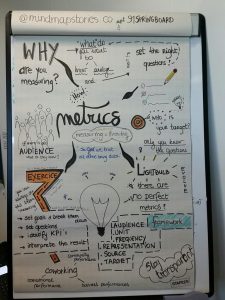 1. Determine the right metrics and indicators
1. Determine the right metrics and indicators
Coworking spaces, like any other businesses, need to measure and quantify performance progress based on defined targets and goals based on various activities. One must consider KPIs (Key Performing Indicators) specific to running a coworking space.
Those metrics will have to be customized according to each activity related to the coworking operations.
We also need to ensure that KPIs are readable, as well as standardized and automated so that everyone can clearly understand these changes.
But first, let’s make sure we first have paid attention on the following things :
- Frequency of the action which is measured (daily, monthly, quarterly, etc)
- Unit used (numbers, currency %, etc)
- Source (such as sales CRM, or a software management tool like Essensys)
- Checklist, dashboard, etc; the audience (team or organisation)
- Target; and how we represent and interpret the final result.
2. Measure the coworking business performances
During the devising metrics masterclass of 91Springboard in Brussels, the participating group worked as one Coworking Space provider with multiple departments and arrived at different conclusions based on various metrics.
Key indicators were used as a way to measure activity in their departments and improve overall performance.
Here are three fields of measurement we can elaborate on : Operational performance, Business performance and Community performance.
A. Operational Performance
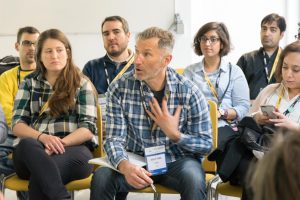 We refer to those items around the regular day-to-day running of the coworking space : efficiency, smooth processes that continually improve with the help of reviewing relevant data…
We refer to those items around the regular day-to-day running of the coworking space : efficiency, smooth processes that continually improve with the help of reviewing relevant data…
Take the example of bandwidth management. What can be done to measure patterns of consumption ?
Example :
- Create utilisation patterns across the day for different types of users
- Do the same by weeks
- Introduce a metric to understand the bandwidth consumption during events
- Etc.
By groing through this, we will able to cater the best possible solutions for upgrades, downgrades and improved infrastructure (access points, router etc) as a whole.
Another example, more focused on qualitative inputs, is : “Good Resolution” by the team running the place.
This can be measured in terms of the number of support tickets for problem-solving, resolution time to close, the sentiment of members after closure and so on.
The overall idea of these operational metrics is to improve the running of the space by going deeper into each one of these elements.
B. Business Performance
The space and its business models must make unit economics sense, for sustainability and scale.
First and foremost, one needs to design the right metrics to provide with the right assessment. Thos metrics might be :
- Revenue per square meter
- Revenue per member
- Revenue per workstation
- Sales conversion ratios
- Cost per lead
- More
It speaks for itself that those are various measures to be reviewed on daily, weekly, monthly, quarterly bais would one want to learn from what’s happening with respect to the business performance, and how he/she stands against our predictions/forecast.
So many proxy metrics of capacity utilization, occupancy, churn serve as second-level/dive-deeper metrics that links back to the root metrics of revenues and expenses.
C. Community Performance
Community is a core element of the why we all love coworking. The idea of creating unique communities that are defined and created by the members for members, which is facilitated by the space providers.
We can improve and measure the internal community dynamic, the external community dynamic, as well as the level of performance regarding events management.
Here are some quantitative and qualitative metrics that can be used to assess the level of engagement of a coworking community:
- Surveys, to deem members’ satisfaction
- Synergies and collaborative projects between members
- Connections and friendships
- Success stories
- Event attendance
- Quality of event feedbacks
- Event attendance patterns
- Etc
Understanding values, beliefs, character, and goals of the space, metrics, which vary from one space to another.
Tracking metrics in a systematic way will develop unique insights, which will make room for new metrics to evolve.
Overall, it will help to draft strategic goals, which can be broken down into more metrics that will answer questions related to personal needs.
Perfect metrics do not exist. However, based on his/her experiences and goals, space managers will find the best metrics that work for them.
Download 91Springboard Metrics presentation :
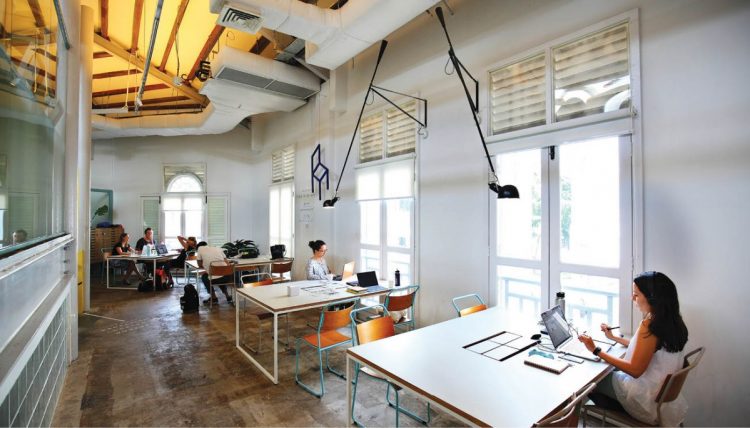
Ben Gattie, the co-founder, and CEO at The Working Capitol wanted to nurture creative work environments in his home country of Singapore. After working for a real estate developer focused on SoHo loft conversions in New York City, Ben returned to Singapore about 8 years ago and set up The Bamboo Group, a boutique real estate company specializing in the redevelopment of neighborhood shop houses. Deciding to enter a more meaningful and multifaceted industry centered around creating inspired work environments for companies big and small, Gattie co-founded The Working Capitol with his sister, Saranta.
Today the professional landscape in Singapore is changing, and it’s all thanks to places like The Working Capitol. We caught up with Ben to discuss these changes and how his work is enabling more open and flexible work environments.
Hi, Ben. What is work culture like in Singapore? Have people embraced social workspaces?
It was quite conventional in a lot of ways until a few years ago with the mainstream emphasizing job security and working out of the central business district. Singapore has made a conscious effort to decentralize, and independent operators such as ourselves have legitimized fringe locations and social workspaces. Thankfully, Singapore is accustomed to change at an aggressive pace and is very adaptable to new things. Singapore apparently has over 60+ co-working spaces so I certainly hope this means people have embraced social workspaces! That said, in our earlier days, it was essential to educate people about what we were doing and to adopt a genuine spirit of giving before we could expect to get in return.
Does TWC aim to promote shared work culture and if so, how?

Ben Gatti
Definitely. We try to promote shared work culture across as many touch points as possible. The design of our space is research backed to promote varied types of interactions, ensuring there are different environments suited for different types of work or social engagement.
We want all our members to feel a sense of ownership of the entire building regardless if they may have signed up for a dedicated workspace. Our events and programming ensure that people come together across different points of interest, which we populate according to the verticals of arts and culture, personal and business development, health and wellness and lifestyle and entertainment.
Furthermore, our team is genuinely interested in what our members do and aims to facilitate interactions and connections whenever possible.
When TWC was being developed, was special attention paid to design?
Yes. Design with intention is key i.e understanding why the spaces exist and for what purpose it serves. Design is always best when it puts the member experience first and naturally weaves these human experiences into the built environment.
In your experience, what type of design promotes a better work culture, while also increasing productivity?
Specifically, in the case of The Working Capitol, the flow of one space into another, the incorporation of natural light, a lively color palette and ensuring there are different types of micro-environments suited for different types of work made accessible to everyone have been major contributors to our unique energy.
Do you believe that the physical design of a shared workspace is an essential part of the model?
It is an essential part of the model. It directly influences not only how well we can perform operationally, but how successful we can be at creating the right energy and interactions. If the hardware is poorly designed, it makes it that much more challenging for our team and all their efforts to bring the space to life successfully, ensuring people are inspired to do their best work.
What types of members do you attract? For example are you focused on the local community or do does TWC extend themselves to digital nomads?
Our members truly span a broad cross section. Being fortunate enough to have an international upbringing and exposure to different cultures, it was extremely important for us to champion diversity in terms of the type of industries we cater to, as well as different stages of development. We welcome everyone from solo-preneurs to large companies. That diversity can only help to provide different perspectives and learnings to local businesses in Singapore and enable people to grow in both business and personally.
On that same note, do you have corporate members or business partners? If so, why do you think that they are drawn to a place like TWC?
Our corporate members tell us the main draw has been to attract and retain the best talent. They want to provide their teams with access to inspiring spaces, access to amenities and opportunities to engage with other members and companies.
CHECK OUT SOCIALWORKPLACES.COM UPCOMING EVENTS
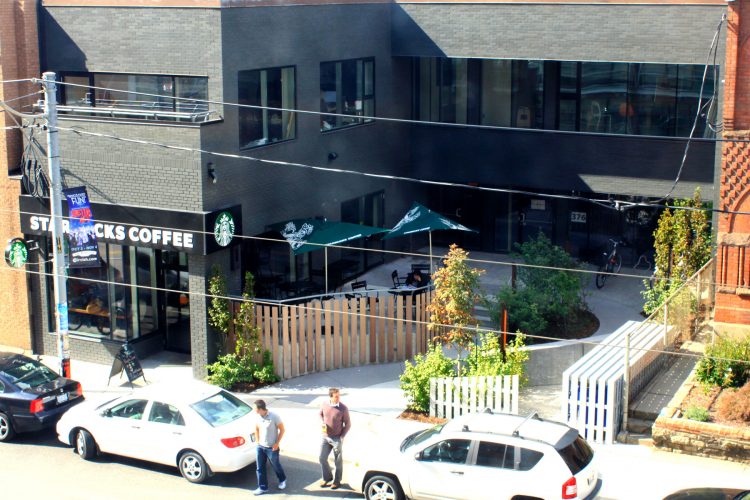
Ashley Proctor runs both Creative Blueprint and Foundery in the vibrant city of Toronto, Canada. The newly renovated 15,000 sq ft community hub is an accessible venue run by Ashley and her business partner, Jake Koseleci, who also owns the property and leases space to Creative Blueprint and Foundery, in addition to a Starbucks.
Established in 2006, Creative Blueprint is a pioneer and leader in Toronto’s arts and coworking communities. Creative Blueprint provides studios, services and support for artists and entrepreneurs. The CB Studios in downtown Toronto are home to practicing visual artists, designers, makers and creative entrepreneurs.
We caught up with Ashley to talk about what it was like to partner with Starbucks and how coffee culture can help coworking spaces grow.
Hi, Ashley. Can you please tell us a bit about the current state of Foundery and Creative Blueprint?
Established in 2010, Foundery currently operates two Coworking and Event Spaces within The Foundery Buildings. Foundery is one of Toronto’s first coworking spaces and we are home to a diverse and vibrant community of passionate, independent freelancers and artists. Foundery provides 2 unique shared coworking environments in addition to private offices and meeting rooms.
In the new year, we are planning to launch an exchange program with our newest Creative Blueprint location in Seattle, Washington (in partnership with Office Nomads).
Why did you decide to partner with Starbucks rather than opening your own coffee shop?
My original plans for a coworking space included art studios, as well as an art gallery and cafe. The businesses are all complimentary and they support each other. The Foundery Buildings were the first venue where we could open all of these elements under one roof. Yet, we had an entire building to renovate and a mortgage to cover, so we decided that it would be a good idea to partner with an established anchor tenant that we didn’t feel bad about charging market rental rates.
At the time when we bought the building, there was construction on the street and we needed to increase foot traffic. Also, coworking was not as popular as it is today and many people were still unfamiliar with the concept. Thus, the cafe gave people a reason to come by and check out the newly renovated building.
Do you feel that this partnership brought Foundery more opportunity?
Yes. Overall, it’s really events, coffee and casual opportunities that make connections and what helped to introduce the community to our space and to the coworking movement.
It has been a great way to find and to introduce people who need a community to the coworking concept. The partnership also offers a secure stream of patrons for the cafe and a secure revenue stream for the building. It also works out well when we need breakfast or coffee for our in-house workshops and events!
What are some of the specific benefits of having a partnership with Starbucks and what does it bring to the tenants and to the space owners?
Our members love coffee. We drink coffee all day and we also like snacks. Since we have our own desks next door, we don’t take up precious real-estate in Starbucks.
As a coworking space operator, I also visit the cafe to tell those people who are working on laptops that there is a better option that’s right next door. I’ve actually invited many cafe customers in for a trial day at Foundery and that worked out well both for Starbucks and for us.
Does having a partnership outside of the space provide the ability to impact the greater community on the whole as you have a wider reach?
Our reach was initially wider with Starbucks as a tenant, but now we have since established our location and our own community. Today, our events and members attract new visitors, like the CB Gallery, which is open to the public during exhibitions and we also participate in many city-wide initiatives that open our doors to the community.
Have you found that there could be a potential risk that your members would want to work in Starbucks, rather than your space?
Quite the opposite. Many people who came to work at the cafe discovered Foundery and decided that the coworking environment was a much better solution. Don’t get me wrong, I really enjoy going out for coffee, but I’d rather work from the Foundery rooftop patio or in my studio with friends. I’m so much more efficient and productive in a coworking space than I could be in any cafe.
What would convince you to have your own cafe?
Now that we have established the model at this location, we’d like to see another service provider operating in the space. We are actually in the process of replacing the Starbucks with an independent operator that is more in line with our vision and mission for the space and community.
As we are a building full of independent artists and entrepreneurs, so it would be nice to see our peers using the space. Yet, we are taking our time in looking for the right cafe partner or collaborator who can provide amazing coffee, healthy food options and catering options for our members and many events.

Like many of the major players in today’s coworking scene, Jean-Yves Huwart, started off as an unsatisfied employee. Driven by a need for more freedom, Huwart quit his job at a media company and started working as a freelancer. Yet, it didn’t take much more than two weeks before he started to get cabin fever. At the same time Huwart was going crazy in his home office, there was talk in Brussels about creating one of the first European Hubs, Hub Brussels, which launched in 2009. Huwart was one of the first members to join the space and he quickly realized that coworking was the epitome of what he had been writing about as a business journalist. For him, this budding movement met the requirements of the rapidly transforming modern workforce and was much more than just a fad.
Hi Jean-Yves, what initially pushed you to start the first Coworking Europe Conference?
Jean-Yves Huwart: While I was working at Hub Brussels I was witnessing, first hand, a growing need for shared workspaces that prioritized human interaction over production. I started looking elsewhere for similar spaces to the Hub, and I quickly figured out that coworking was a growing phenomenon that could be found all over Europe. This was the initial inspiration to start the first Coworking conference, and because Brussels is the capital city of Europe, it made sense to identify as a European conference.
When did you have the first event, and what was coworking community like in its early stages?
The first event took place in 2010. We expected around 50 people but instead 150 showed up. At that moment, we understood that something was really cooking. At the time, spaces were still in their nascent stages, Betahaus in Berlin was just one year old, and many of the big names you see in coworking today were just starting out. Because things were still operating on a smaller scale, we were able to easily connect with a lot of people who were developing spaces, and also the individuals who had knowledge about the coworking movement.
What countries, at the time, had the most advanced coworking scene? And how did these developments help develop the Coworking Europe Conference?
In 2010, many of the people we met at the conference came from Germany, which was the most advanced coworking scene at the time. They were already organizing themselves into an association, Coworking Deutschland, which was something that was ahead of its time. After the conference, Coworking Spain started and you also had a strong Italian scene growing.
Because of these coworking associations that were forming, people started looking at ways in which they could come together, thus the people in Berlin invited us to have our conference there for the next year, which was in Betahaus, and Club Office. Then, when we were in Berlin, we met the people from Paris who invited us for the next year and from there we gained more traction and the interested has never stopped growing.
From the first Coworking Europe, a real community was formed, so while the conference is still a yearly event always open to newcomers, it’s also an annual gathering of people who see each other as a family.
As someone who has been there from the very beginning, what are some of the major developments you have seen in the coworking over time?
In a lot of ways we grew up alongside many of today’s more developed coworking spaces, so we have really seen the ways in which the movement has changed over time. We also had the chance to see the way that spaces [have] experimented since the very beginning.
One thing that has changed over time is that coworking operators have learned how to monetize their spaces. Many of the people who attended the first conference were interested in coworking, not so much from a business perspective, but rather as a side project.
Today, the coworking community is playing a major role in how new economies will be structured in the future, as they are paving the way for an innovative workforce.
What are some of the major trends that you see currently in the coworking scene?
This year we had 360 attendees in Milan, which was comprised of experts in the field and also many newcomers. After Milan, we can really say coworking is steadily growing as an industry, which has become more and more mature, while still acting as a source of inspiration for various curators. One thing we’ve seen is that there is a whole new set of players interested in coworking, from government, employees to corporations.
These different sectors are interested in coworking because it is shaping the workspace of the 21st century. They realize that the function of the workplace is changing and that it is more focused on interaction and the human experience. Overall, the sharing economy, co-living, and collaboration are key elements to success in the business world today.
What do coworkers expect today that they didn’t before?
There is certainly more insight available, but what we do see, now more than ever, is that people are interested in growing a business and the proportion of spaces created purely as a social project has decreased. This doesn’t mean that the passion and the ideals have disappeared, but it does mean that coworking is approached in a more mature way. The more the movement grows, the more we understand the economics behind it, such as the importance of having private offices and services, which can generate income.
For example, the initial results of the Global Coworking Survey, which was presented at the conference, showed that more spaces than ever are looking to expand.
We also heard a lot about the emerging trend of coworkcation, what does that say about the way we approach contemporary work styles?
This year’s conference presented more data and hard facts than ever before. We are seeing the rise of different concepts driven by coworking, like “coworkation,” which presents a completely new approach to freelancing. We had several presentations on the topic, from Hubud in Bali and also Neo-Nomad. This increasing global mobility for employees and employers will be a cause a dramatic change in the way we see travel and it will also impact tourist destinations. In the future we could see a significant population of the workforce moving freely and it may eventually be the standard way to make global connections.
In addition to nomadic freelancers, many people are discussing the relationship between coworking and corporations. It has always been a topic, but now we see people developing strategies to make this relationship a reality. Corporations in the future will most likely look like today’s coworking spaces. In many ways, large enterprises need to look towards the coworking model in order to remain relevant in the future.
You also had the first Coworking Africa conference in Cape Town this year. What were some of the most significant takeaways and what did this experience tell you about the global coworking community?
The reaction was very positive. We saw that in the same way that coworking is important in Europe, it is equally, if not more, important in developing countries. For us, basic standards like fast internet in an office space is a commodity, but this not the case in Africa. In the coworking community in Africa, the primary role of the movement is to provide basic infrastructure at an affordable cost. In addition to meeting basic needs, coworking also brings a lot added valued in regards to social engagement, both on a local and global level, in the African community.
What do you predict the future of coworking will look like?
If we keep seeing the value system of the sharing economy as a main force behind the development of new economic models, coworking spaces will be one of the most visible parts of this transformation. The coworking movement will go beyond the conceptual stage and become the physical manifestation of the collaborative economy. While walking through a cityscape, coworking spaces will line the streets, much like factories and offices did in the last industrial boom.
Note: This article was originally posted on Shareable
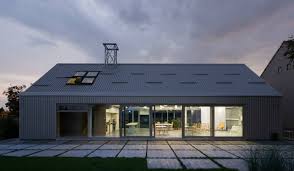
An increasing amount of companies are realizing the benefits of the coworking movement. Retreats are a big part of the changes taking place in the workplace, and offer a welcome opportunity for both newcomers and experienced players to get away from their everyday routine. The majority of people imagine these retreats to be on tropical islands, yet as the concept has spread rapidly, there are now getaways being offered in more off the grid areas.
In Mokrin, a village in the the province Vojvodina Serbia, a new coworking retreat will be launching this year, offering workers the chance to explore the idyllic Serbian landscape while also gaining exposure to potential local and international collaborations. We spoke with Ivan Brkljac, project leader of Mokrin House about what their latest project offers to nomadic workers.
Hi Ivan, can you please tell us a bit about the project and what inspired you to start Mokrin House?
I am the project leader of Mokrin House, which is an urban coworking retreat in a rural part of Serbia. We offer an ideal place to get away from the large city chaos and focus on your work. Even though Mokrin House is in the remote countryside, you will feel anything but isolated. We offer the chance to connect with like-minded people, such as other digital professionals who enjoy a work-life balance at a rustic pace.
What would a typical day at Mokrin look like?
Imagine your day like this: A morning jog through the fields, giving you energy to then focus on your work or current projects. For lunch, you will have a healthy home-cooked meal prepared for you at the estate. After some more work, you have the option of going on a bike ride into the village, or a swim in the pool (best in summertime) or even just relaxing with coworkers, over a glass of wine on the porch. That’s how we envision our coworking retreat.
How long have you been in operation and did you face challenges when introducing your space to the public?
The estate has been in operation since 2012, however, most of the activities to take place there so far, have been corporate and large enterprises. In addition to these events, we have also had many arts and culture workshops, such as ceramic workshops, concerts, exhibitions, and so on. Today, we are focusing more on the rising coworking movement, as we feel it is a better fit for us.
The coworking retreat will start in the Spring of 2016 and in the beginning, spreading the word has been challenging. But the more we explain the concept to the people, the more they become interested. In fact, several reservations for the spring launch have already been made.
Most of the coworking activity is located in Belgrade, what could you offer to those who are unfamiliar with rural parts of Serbia?
Belgrade has a vibrant startup and freelancing community buzzing with new ideas and projects. However like all large cities, living and working there has its downsides. Traffic jams, lack of parking, air pollution, and higher prices are just some of the difficulties that you might encounter. On the upside, Belgrade has great nightlife scene, a lot of cultural events, interesting young people and much more. What we offer in Mokrin House is not opposite of what Belgrade or other large European cities offer, in fact, we consider our space to be complimentary to urban environments.
All of us sometimes need to get away from the noise and crowd and just restart ourselves, and there is no better way to focus on your work than changing your environment, especially one that is designed to to boost your productivity during your “work” time and ensure maximum relaxation during “after work” hours.
In Serbia, many of the rural areas have faced economic hardship. Do you think that offering a space where people can create and also stay for an extended period of time will help revitalise rural regions? If so, why? Have you already seen any positive signs?
There are several positive effects a coworking space in the rural area has to the local community. First, and most apparent is the positive economic impact. We hire several people from the local village as staff and these jobs wouldn’t exist without the space. Also, most people who stop by Mokrin house, usually purchase some of the local produce, such as excellent cheese or homemade rakija. Apart from the sheer economic benefits, the local community is always invited to take part in educational and cultural workshops and seminars, which has unmeasurable nonmaterial benefits.
Are there any government/state initiatives that have helped you grow and develop? If you were to make such a partnership how would you define your added value?
No. We have not worked with any government bodies and at the moment we are not really considering these types of partnerships.
What types of services/perks do you offer and what kinds of people do you typically attract?
The most important thing we offer is an ideal work environment. Everything else, from cooking classes, pottery classes, healthy homemade food, afternoon bike rides, mulled wine, to swimming in an eco-friendly pool comes as an extra perk. People who are attracted by the idea of Mokrin House are the ones who cherish the work-life balance and who understand how important it to travel, change working environments and meeting new, creative people.
Do you have any plans to expand/make changes/ add-ons to cater to a certain group?
Our expansion plans depend on the markets readiness to adopt this new concept. Our final vision is to revitalise an entire rural village of Mokrin, by making it the biggest and the most diverse coworking village in the world with Mokrin House in its centre.
As a space operator, what are some of the key changes needed in your community? What do people need to improve their professional lives, and how can your space offer this?
As a space operator, I need to make sure that all the coworkers are living the experience that they expect. The spring of 2016 will be the first time that we focus solely on coworking, so we will consider the many changes needed to be made in order to fulfil everybody’s needs.
You were at Coworking Europe this year. Was it your first time, and what were you looking to gain from the experience? Was there some good input you were able to take away and apply to your own projects?
This was my first European Coworking Conference, and surely not the last. The conference gave me a chance to get to know many people who are on the same path as Mokrin house. Two things left the biggest impression on me. The first one was the statistics that have showed how fast the coworking movement is expanding, confirming that we are on the right track. The second thing that was very noticeable that almost none of the coworking spaces have an identical model. Every space is different and unique, showing that the industry understands that each community is different and requires different things.

Last year, the coworking movement hit an all-time high. With conferences in Europe, Africa, the USA and Canada, it has become evident that coworking is not only growing in established communities but all over the world.
Dr. Ritesh Malik, founder of Innov8 coworking in Delhi, believes that coworking will be essential to business growth in India. We spoke with Ritesh about the current coworking scene in Delhi and what the emerging movement has accomplished so far.
Hi, Ritesh, can you please introduce yourself and tell us a bit about Innov8 Coworking?
I am a doctor by education, but a passionate entrepreneur and startup lover at heart. I started my first venture back in 2012 and eventually sold it to Times of India group (Alive App). Over the last 2 years, I have been deep into startup funding, and I am actively working with the government of India in order to help build college entrepreneurship ecosystem in the country.
I have also spent some time in Boston, Santa Clara, LA, London etc. and have understood how these types of silicon valleys have been built over time. I realized that Silicon Valley is not a real estate but a mindset, and that is what we’re trying to build today in Delhi.
You say on your website, “we believe Entrepreneurs & Startup Enthusiasts of Delhi deserve better”, can you explain what was lacking, and has coworking improved the lives of professionals in Delhi?
24% of all the startups in India are from Delhi, but until now Delhiites weren’t exposed to startup community building. I personally feel that the most integral part of startups is the community building. It’s all about people. At Innov8, we are not focusing on the office spaces, which we provide, rather office spaces are just 10% of our business, and 90% of our focus is on community building.
We organize events (almost 1 per day) based on skill development, which helps entrepreneurs to scale up, build, break and innovate. The idea is to provide an innovative space right in the centre of Delhi where we can converge the biggest talents and create the most vibrant community in Delhi.
I feel that the most vital aspect of a startup is the community building, startups are all about tinkering. They’re about meeting new people, interacting with them and synergizing win-win situations to create growth hacking and disruption within conventional business models.
How would you describe the coworking movement in Delhi? Is it popular, and if not, what are coworking leaders doing in order to help spread the movement?
Delhi is very immature when it comes to coworking awareness. We only got our first coworking centre back in 2012. There is a very thin line between coworking, accelerators and incubation centers in Delhi. Most of the coworking centers in Delhi are not focused on coworking, but rather focused on incubation. At Innov8 we’re very clear about our mission, we’re a pure play-coworking centre and we just aim to build the most vibrant & helpful startup community in the city.
At Innov8, we are also reaching out to the universities and educating the students about coworking. In Delhi people still have a notion that coworking is all about shared office space, but we want to change that.
What types of members do you typically house at Innov8? Are they mostly freelancers or are there members from companies?
We have a strict application process to join our coworking centre. This is for the first time in the world when coworking centers screen the applications before allowing applicants to be a part of the ecosystem. The reason for this process is because we want to keep track of the people who are part of our community. We want to attract the most intellectual and innovative minds.
Today, we focus on getting more entrepreneurs, investors, and product-based startups to be a part of the ecosystem. We are also working on a program to help freelancers build their own products by bringing 2 to 3 freelancers together.
In your experience, is coworking helping to transform work in Delhi. For example, are more corporate entities open to changing their work environment, like using a coworking space?
Not yet, but I feel that over time coworking centers are going to transform the way businesses are done in India. Perceptions of coworking are already changing. For instance, we got a request from the Kotak Mahindra Bank, as they want their CIO & his team to move into Innov8 so they have the chance to think outside the box and have a wider vision of the startup ecosystem.
What types of services do you offer and are there any particular needs that your members have? Such as events, support, education?
Mortar office space is just 10% of what we offer. We believe that more than the office space, what startups need most is the community, mentorship and access to networks. We help them build these networks by creating a fertile ground for ideas via thought leadership. We focus on skill development and also offer a virtual acceleration program where we provide our startups with a startup handbook, which includes the the do’s and don’ts.
How would you describe the design of your space? Were you inspired by any particular model, such as open workrooms, private offices, café, breakout rooms, etc.
We have one of the most beautifully designed campuses in India, we were featured in OfficeLovin, one of the best office design magazines in the world. Our space is a combination of modern design and contemporary artwork.
What seems to be the most effective types of spaces that nurture productivity in your community?
We have an ideation cube, a white boarding room, an amphitheater, common innovation zone as well as an open terrace. These are the areas, which are full of innovation and entrepreneurial drive.
Your site often mentions Silicon Valley. Do you aspire to be the next Silicon Valley or are you creating your own ecosystem specifically for your community? Do you think coworking spaces are important to creating hubs for innovation, and if so, why?
I believe that coworking centers are the mecca of innovation worldwide. We are on a mission to make Delhi as the next Silicon Valley after SFO, Tel Aviv, Bengaluru etc. Silicon Valley is not a real estate, but a mindset; we’re changing the mindset.

For the first time ever, Coworking Europe hosted the Coworking Europe Awards in 2016. The event included two categories, one for best design and one for best community action. Spaces and operators submitted their concepts and projects to be voted on by the coworkers from around the world. The awards allowed for Coworking Europe to showcase some of the top initiatives taking place today in the global coworking community.
The winners were judged on the range of innovative steps taken towards their unique design, or actions towards community building. This year’s Coworking Europe Awards also honored the winners with prizes worth more than 3.000€. Awards included 6 months free membership on the ESSENSYS platform and 12 months usage of the KISI smart-locking system for your space free of charge. In addition to practical tools, Coworking Europe also providence a placement on a Coworkation trip to Barcelona and two tickets to Coworking Europe 2017.
Smart Office takes home first prize for the Coworking Community Action Award
The winner of this year’s Best Community Action Award was presented at the Coworking Europe Conference in Brussels, to Miroslav Mijatov, founder of Smart Office in Belgrade, Serbia. Smart Office recently expanded their space and network by moving into a new space in the city center in the Serbia capital. In addition to physical growth, Smart Office also extended their community by reaching out to those in need. The award was presented to the Smart Office community for their initiative to help refugees and displaced persons by using their community and resources.

Miroslav Mijatov, winner of the Best Community Action Award.
In his presentation of the project, Miroslav explained that as Serbia is both a country in transition and a hub for refugees and immigrants, the Smart Office sees these changes not in a negative light, but an opportunity to garner community spirit and offer support. Their event, titled “Refugee Fundraiser – Quiz Night”, grew and strengthened the Smart Office community, opening their doors to those who had nowhere to go for quiz and games night.
Smart Office members also had the option to bring donations, including clothing, hygiene items, food and water, packaging, baby products, blankets and other items. Ultimately, their actions also brought in donations, which enabled the space to provide 100 meals for those in need. Not only was this initiative fueled by doing something for the greater good, but also strengthened the Smart Office team. Today they are recognized as a coworking space where members value generosity and genuine community building.
KantoorKaravaan wins Best Coworking Design Award
It’s hard to pick just which coworking space has the best design. Coworking spaces by nature are innovative, imaginative and flexible, and just like coworking communities, they all have their own special touch. This yeah at the first Coworking Europe Design Awards, the winner brought us something pretty unique: mobile coworking. Kontoorkaravaan provides coworking offices that are on the go. Setting up shop in converted caravans, the fully equipped coworking caravans are integrated with the great outdoors, making scenic stops along the way.

KantoorKaravaan
Kontoorkaravaan hails from the Netherlands, but currently has coworking stations setup in various locations. The caravans are designed to have offices that face the great outdoors, allowing coworkers to enjoy the view and stay focused. Kontoorkaravaan also accommodates larger groups, with mobile workstations with large tables for meetings and group work. At the end of a productive day, coworkers set up a full camp with different caravans and tables in the middle.
The Coworking Europe Awards were sponsored by Essensys

Source:
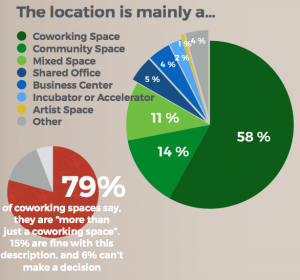
2016 has earned the title of being a difficult year. Luckily, 2016 wasn’t all bad, especially when it comes to coworking. As the movement matures, we see the the annual growth rate slowing down, which is a sign of the industry now focusing on fine tuning and improvement, rather than responding to the excitement of the trend, like in previous years.
Recently, Deskmag’s annual Global Coworking Survey, in collaboration with Socialworkplaces, was presented last month at Coworking Europe in Brussels. We now bring you the full results of the survey.
Growth in the market: Past and future

Last year, the coworking industry boasted an increase in stability after facing less than perfect conditions in 2015. We also saw substantial growth in regards to the number of spaces worldwide, approximately 11,300 coworking spaces with 835,000 members.
The 2017 Global coworking Survey predicts that there will be an estimated 13,800 active coworking spaces worldwide. An additional 2,500 to be exact. The 2017 survey projects that from these additional spaces the amount of coworking members around the world will increase to slightly over 1 million members. The predicted number, 1,180,000 will show an increase of about 41 % from last years 64%.

One of the major questions as the movement progresses is: How do coworking spaces define themselves? Well about 79% of spaces say that they are “more than just a coworking space”, while 15% sit comfortably as coworking spaces, and a slight 6% remain undecided. The central elements that make a space more than simply a coworking space is the addition of events, business accelerators and coffee shops. One thing that seems to remain relatively stable is the informal element of coworking that we all know and love. Around 60% of spaces were self-described as “casual”.
How sustainable is coworking today?
One thing that has certainly increased in profitability. Compared to all previous years, coworking spaces around the world are at their most profitable, at 41% a little step above 36% in 2015.
When it comes to sustaining staff and operations, 44% of staff feel that their compensation is “rather good”, while operators and founders are only at 20%. Of course, these spaces are often a labor of love so it can take time to turn a profit. Hopefully 2017 will bring in the money for these hard working space operators.
 When it comes to bringing in new members, the majority of coworking spaces, 80%, site social media, specifically Facebook, and online presence as the biggest attractor. Coming in at a close second at 78% was community building, followed by events, free trials, with coworking associations coming in last. For many current and future operators this types is extremely important as it can help them increase their network and become more sustainable in the future. As the movement advances, we even know which SEO keywords can help build your online presence, most often in combination, such as “shared space” or “coworking space”.
When it comes to bringing in new members, the majority of coworking spaces, 80%, site social media, specifically Facebook, and online presence as the biggest attractor. Coming in at a close second at 78% was community building, followed by events, free trials, with coworking associations coming in last. For many current and future operators this types is extremely important as it can help them increase their network and become more sustainable in the future. As the movement advances, we even know which SEO keywords can help build your online presence, most often in combination, such as “shared space” or “coworking space”.
How have coworking members evolved?
It’s heartwarming to see that coworking still remains open. While there will always be coworkers who require more privacy, or a team office, 75% of coworkers still work in open and flexible areas. This was only a 2% decrease from a reported 77% in 2015/2016. 
In order to ensure a healthy and comfortable workspace, operators and management can gather important insight from the survey to better suit their member’s needs. For example, the majority of coworkers use basic office furniture, but more than half ( around 76% ) of coworkers would like to sit in an ergonomic office chair.
When it comes to collaboration, we still see similar numbers as we did in 2015/2016, yet with a little less communication. 55 % percent of coworkers said that they work on their own primarily, which is a slight decrease from previous years. This could be due to the fact that more coworking spaces now present themselves to a wider variety of professionals, such as corporate employees, who may or may not have time or interest when it comes to the social side of coworking. In terms of collaboration between members, 71% of participants said that they have collaborated with other members within the last 12 months, at an average of 4 collaborations.
Coworkers have an increase in satisfaction
Today the majority of members have found out about their coworking space via word of mouth, followed closely by internet searches and company/ client recommendations. Based on member ratings, spaces earned 8,17 out of 10, which was an increase from last year’s 8,3. In addition to high ratings, there was also an increase in the amount of hours members used their coworking space. 71% of survey participants claimed to have worked at their coworking space three times a week, or more, while 41% use their space every day.
When it comes to payments. The majority of members, 61%, pay for their coworking space memberships themselves. 26% of memberships are paid for by an employer, which could increase in the near future as more companies allow their employees to work remotely.
What does coworking in 2017 look like?
Just a few days away from ringing in the new year, we are once again opening ourselves up to new resolutions. Last year, 62% of coworking spaces planned for at least one additional expansion, which has gone up to 67% in 2017 projections. 42% of those spaces are planning to open an additional location, while 25% plan to expand within their current space.
As for people power, 85% of spaces believe there will be in an increase in members, which came in slightly lower when compared to previous years. In terms of income flow within the space, around 78% of spaces believe there will be an increase in income, which was also down 4% from 2015/2016. 
Overall, coworking has matured over the last decade and today we see the movement as well beyond a fad as it becomes a standard of workplace inspiration. So this year, as you plan to spend less time on your phone, or lose weight, don’t forget to invest time in your coworking community!
Download your own copy of the survey :







Recent Comments